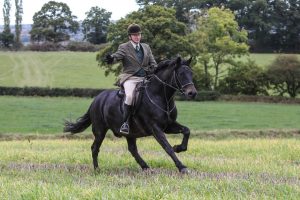The Horse and the Barrel

A good gallop
I ride quite a lot – not competitively, just for fun. Some months ago now, I was with my Alexander Technique pupil Jane, hacking around the lanes and fields of the Blackdown Hills, a truly magical landscape. But I digress.
During our first Alexander Technique studio session, we had discussed Jane’s creaks and groans, amongst which were a herniated disc in her lumber spine and a torn muscle in her left shoulder. Recently she had to give up much of her riding; and a day’s hunting was just too much for her. So her horse now lives with us.
As you can see, he is a mixture of Exmoor pony and something much larger. He has the resilience of the Exmoor, and is often difficult to motivate, but is nonetheless kind hearted.
In in our AT teaching session, Jane and I worked with the concepts of non doing and letting go (not flop) and the insidious nature of subconscious habits amongst other things. In the process we noted a few of the tensions evident in her back and shoulders and Jane was surprised to discover that these were manifest throughout her whole self, including her legs, arms, and of course her neck.
Now, out riding I could not help but notice that Jane’ s upper torso rolled around like a loose barrel on a ship at sea, whilst her legs were clamped firmly to the horse’s flanks with a lot of tension evident in her thighs. Gosh what a lot of work that seemed to be.
I was trying to work out whether the rolling around started at her hip girdle or her shoulders, and concluded that it was mostly shoulders – she said she could feel her sitting bones in contact with the saddle all the time. She was, of course, rigidly clamped to the saddle, and compensating for the horse’s gait by moving her shoulders.
It seems to that Jane thinks this is relaxed riding – it’s something she has done for the past 40 years or so since she started riding at the age of nine. Evidently, Jane thinks that this extraneous movement is helpful to the horse, but in fact it’s not. The poor horse is having to compensate for this constant shifting of weight on his back, by stiffening himself in an effort to remain stable. Amongst other things this manifests itself as reluctance to allow his feet be lifted.
Now I cannot say – at least not yet – that any progress has been made with Jane’s use, but I am hoping she will come for more lessons – she said she would, when she has finished her course of Pilates. We shall see. The horse, meanwhile, now responds much better than he did to a more stable rider and is beginning trust that he will not fall over whenever one of his feet is lifted to pick out the stones.

Comments
The Horse and the Barrel — No Comments
HTML tags allowed in your comment: <a href="" title=""> <abbr title=""> <acronym title=""> <b> <blockquote cite=""> <cite> <code> <del datetime=""> <em> <i> <q cite=""> <s> <strike> <strong>